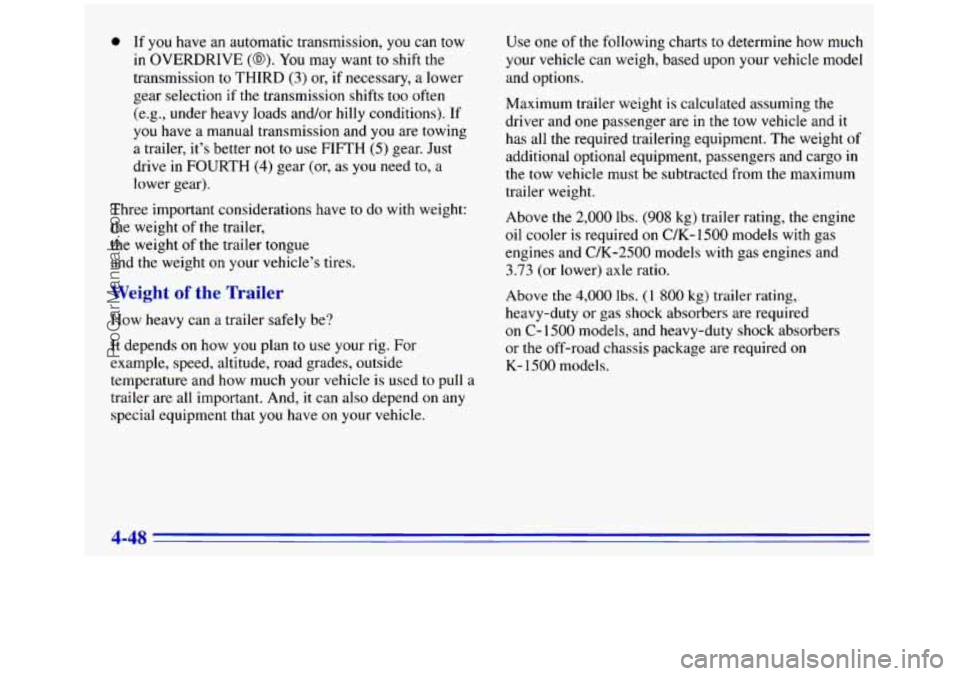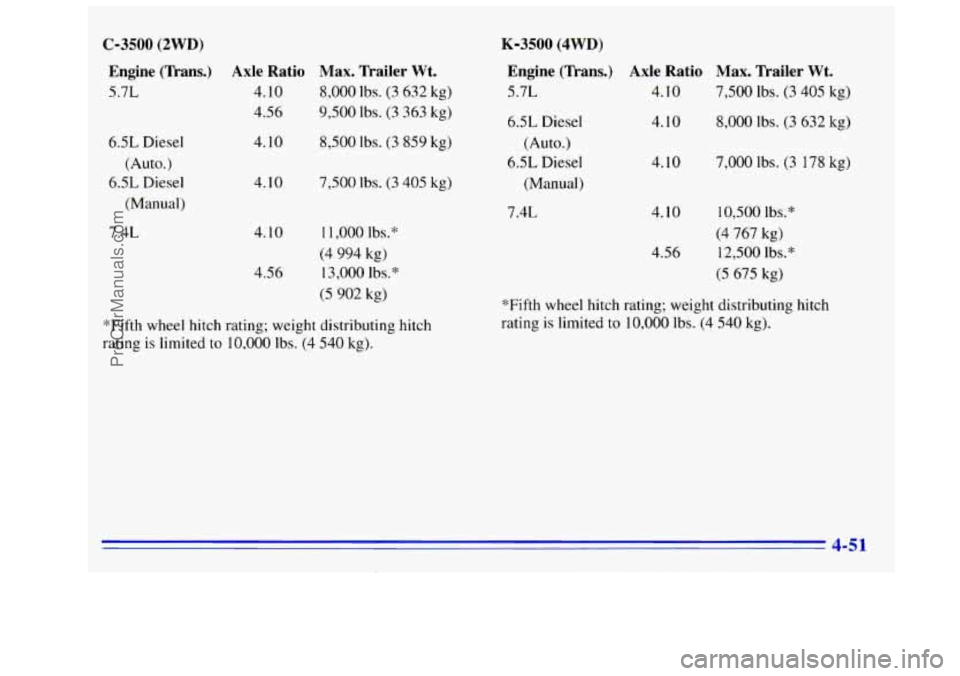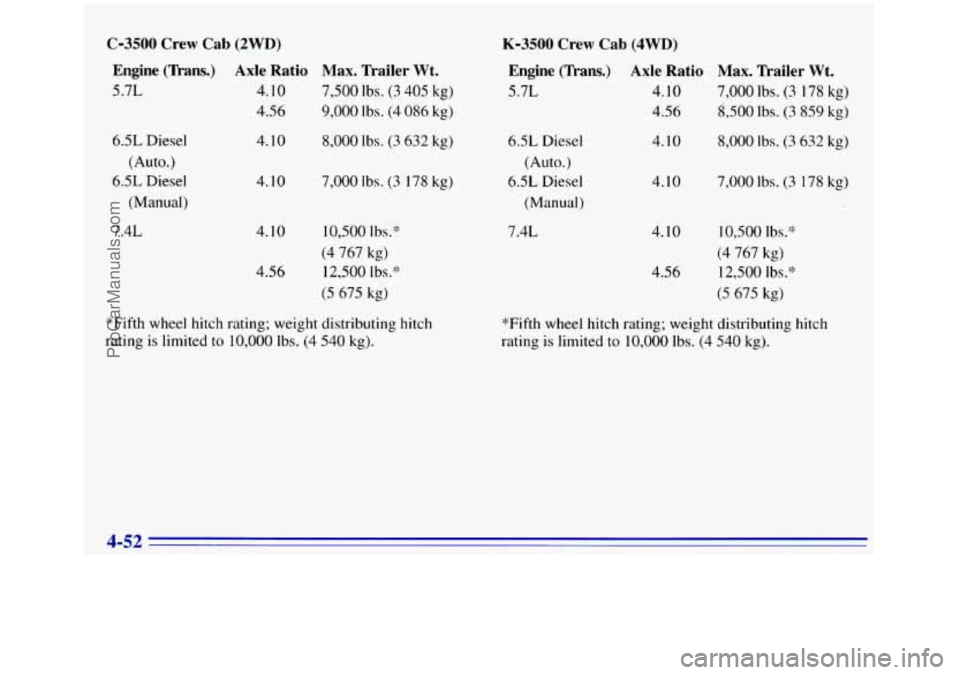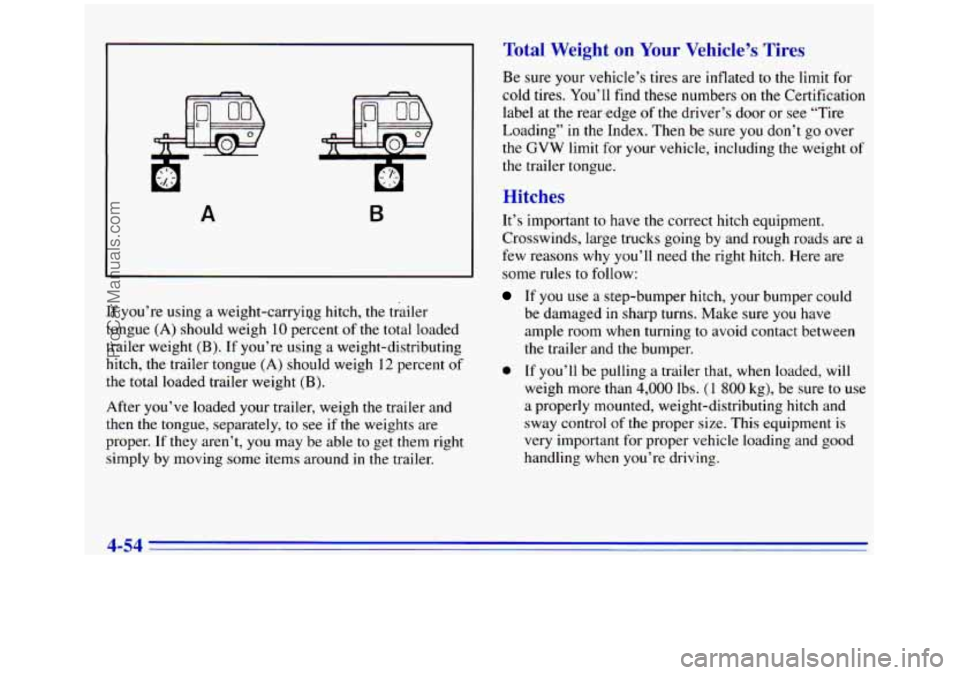1996 GMC SIERRA weight
[x] Cancel search: weightPage 200 of 404

Trailer Recommendations
You must subtract your hitch loads from the CWR for
your vehicle. Weigh your vehicle with
the trailer attached,
so that you won’t go over the GVWR or GAM.
You’ll get the best performance if you spread out the
weight
of your load the right way, and if you choose the
correct hitch and trailer brakes.
For more information, see “Trailer Towing” in the Index.
Camper Wiring Harness (Option)
A five-wire harness is stored in the front stake pocket on
the driver’s side of the bed. The harness has
no
connector and should be wired by a qualified electrical
technician.
It must be routed out. of your vehicle and
securely attached
so that it won’t be pulled or rubbed
while you’re using it. Store the harness in it’s original
position. Wrap the harness together and tie
it neatly so it
won’t be damaged.
Pickup Conversion to Chassis Cab
General Motors is aware that some vehicle owners may
consider having the pickup box removed and
a
commercial or recreational body installed. Before you
do so, first contact the GM Zone Office for your area for
information on such conversions specific to this vehicle. (See the
“Warranty and Owner Assistance” booklet for
Zone Office.) Owners should be aware that, as
manufactured, there are differences between
a chassis
cab and a pickup with
the box removed which may
affect vehicle
safety. The components necessary to adapt
a pickup to permit its safe use with a specialized body
should be installed by a body builder in accordance with
the information available from the Zone Office.
Towing a Trail-r
If you don’t use the correct equipment and drive
properly, you can lose control when you pull a
trailer. For example, if the trailer
is too heavy, the
brakes may not
work well -- or even at all. You
and your passengers could be seriously injured.
Pull a trailer only if you have followed all the
steps in this section. Ask your
GM dealer for
advice and information about towing a trailer
with your vehicle.
I
4-46
ProCarManuals.com
Page 202 of 404

0 If you have an automatic transmission, you can tow
in OVERDRIVE
(@). You may want to shift the
transmission to THIRD (3) or, if necessary, a lower
gear selection if the transmission shifts too often
(eg, under heavy loads and/or hilly conditions). If
you have a manual transmission and you are towing
a trailer, it’s better
not to use FIFTH (5) gear. Just
drive in FOURTH
(4) gear (or, as you need to, a
lower gear).
Three important considerations have to do with weight:
the weight
of the trailer,
the weight
of the trailer tongue
and the weight
on your vehicle’s tires.
Weight of the Trailer
How heavy can a trailer safely be?
It depends on how
you plan to use your rig. For
example, speed, altitude, road grades, outside
temperature and how much your vehicle is used to pull
a
trailer are all important. And, it can also depend on any
special equipment that you have on your vehicle. Use
one
of the following charts to determine how much
your vehicle can weigh, based upon your vehicle model
and options.
Maximum trailer weight is calculated assuming the
driver and
one passenger are in the tow vehicle and it
has all the required trailering equipment. The weight
of
additional optional equipment, passengers and cargo in
the tow vehicle must be subtracted from the maximum
trailer weight.
Above
the 2,000 lbs. (908 kg) trailer rating, the engine
oil cooler is required
on C/K- 1500 models with gas
engines and
C/K-2500 models with gas engines and
3.73 (or lower) axle ratio.
Above
the 4,000 lbs. (1 800 kg) trailer rating,
heavy-duty or gas shock absorbers are required
on
C- 1500 models, and heavy-duty shock absorbers
or
the off-road chassis package are required on
K-1500 models.
4-48
ProCarManuals.com
Page 205 of 404

C-3500 (2WD)
Engine (Tkans.) Axle Ratio Max. Trailer Wt.
5.7L 4.10 8,000 lbs. (3 632 kg)
4.56 9,500 Ibs. (3 363 kg)
4.10
8,500 Ibs. (3 859 kg) 6.5L Diesel
(Auto.)
6.5L Diesel
(Manual)
7.4L 4.10
4.10
4.56 7,500 Ibs. (3 405 kg)
11,000 Ibs."
(4 994 kg)
13,000
Ibs.*
(5 902 kg)
*Fifth wheel
hitch rating; weight distributing hitch
rating
is limited to 10,000 lbs. (4 540 kg).
K-3500 (4WD)
Engine (lkans.) Axle Ratio Max. Trailer Wt.
5.7L 4.10 7,500 lbs. (3 405 kg)
6.5L Diesel
(Auto.)
6.5L Diesel
(Manual)
7.4L 4.10
4.10
4.10
4.56
8,000 lbs. (3 632 kg)
7,000 Ibs. (3 178 kg)
10,500 lbs.*
(4 767 kg)
12,500 lbs.*
(5 675 kg)
*Fifth wheel hitch rating; weight distributing hitch
rating is limited
to 10,000 lbs. (4 540 kg).
4-51
ProCarManuals.com
Page 206 of 404

C-3500 Crew Cab (2WD)
Engine (Trans.) Axle Ratio Max. Trailer Wt.
5.7L 4.10 7,500 lbs. (3 405 kg)
4.56 9,000
Ibs. (4 086 kg)
6.5L Diesel
(Auto.)
6.5L Diesel
(Manual)
7.4L
4.10
4.10
4.10
4.56
8,000 lbs. (3 632 kg)
7,000
Ibs. (3 178 kg)
10,500 lbs.*
(4 767 kg)
12,500
Ibs.*
(5 675 kg)
*Fifth
wheel hitch rating.; weight distributing hitch
rating
is limited to 10,000 lbs. (4 540 kg).
K-3500 Crew Cab (4WD)
Engine (Tkans.) Axle Ratio Max. Trailer Wt.
5.7L 4.10 7,000 Ibs. (3 178 kg)
4.56 8,500
Ibs. (3 859 kg)
6% Diesel
(Auto.)
6.5L Diesel
(Manual)
7.4L 4.10
4.10
4.10
4.56
8,000 Ibs. (3 632 kg)
7,000
Ibs. (3 178 kg)
10,500
Ibs*
(4 767 kg)
12,500
Ibs?
(5 675 kg)
*Fifth wheel hitch rating; weight distributing hitch
rating
is limited to 10,000 Ibs. (4 540 kg).
4-52
ProCarManuals.com
Page 207 of 404

(2-3500 HDiChassis .Cab Engine (Trans.) Axle Ratio
Max. Trailer Wt.
5.7L 4.63 8,500 lbs. (3 859 kg)
5.13
8,500 lbs. (3 859 kg)
6% Diesel
(Auto.)
6.5L Diesel
(Manual)
7.4L 4.63
5.13
4.63 5.13
4.63
5.13
8,000 lbs. (3 632 kg)
10,500 lbs.*
(4 767 kg)
7,000 lbs. (3 178 kg)
8,500 lbs. (3 859 kg)
12,500 lbs.*
(5 675 kg)
12,500 lbs.*
(5 675 kg)
*Fifth wheel hitch rating; weight distributing hitch
rating is limited to 10,000 lbs. (4 540 kg). You
can ask your dealer for our trailering information or
advice, or you can write us at the addreis listed in your
Warranty and Owner Assistance Information Booklet.
In Canada, write to:
General Motors of Canada Limited
Customer Assistance Center
1908 Colonel Sam Drive
Oshawa, Ontario LlH 8P7
Weight of the Trailer Tongue
The tongue load (A) of any trailer is an important
weight to measure because it affects the total or gross
weight of your vehicle. The Gross Vehicle Weight
(GVW) includes the curb weight of the vehicle, any
cargo you may carry in it, and the people who will be
riding in the vehicle. And if you will tow a trailer, you
must add the tongue load to the GVW because your
vehicle will be carrying that weight, too. S&e “Loading
Your Vehicle” in the Index for more information about
your vehicle’s maximum load capacity.
4-53
ProCarManuals.com
Page 208 of 404

A B
If you’re using a weight-carryipg hitch, the trailer
tongue
(A) should weigh 10 percent of the total loaded
trailer weight
(B). If you’re using a weight-distributing
hitch, the trailer tongue
(A) should weigh 12 percent of
the total loaded trailer weight
(B).
After you’ve loaded your trailer, weigh the trailer and
then the tongue, separately,
to see if the weights are
proper.
If they aren’t, you may be able to get them right
simply
by moving some items around in the trailer.
Total Weight on Your Vehicle’s Tires
Be sure your vehicle’s tires are inflated to the limit for
cold tires.
You’ll find these numbers on the Certification
label at the rear edge
of the driver’s door or see “Tire
Loading” in the Index. Then be sure
you don’t go over
the
GVW limit for your vehicle, including the weight of
the trailer tongue.
Hitches
It’s important to have the correct hitch equipment.
Crosswinds, large trucks going by and rough roads are a
few reasons why you’ll need the right hitch. Here are
some rules
to follow:
If you use a step-bumper hitch, your bumper could
be damaged
in sharp turns. Make sure you have
ample room when turning
to avoid contact between
the trailer and the bumper.
0 If you’ll be pulling a trailer that, when loaded, will
weigh more than
4,000 Ibs. (1 800 kg), be sure to use
a properly mounted, weight-distributing hitch and
sway control
of the proper size. This equipment is
very important for proper vehicle loading and good
handling when you’re driving.
ProCarManuals.com
Page 209 of 404

Y
You should always attach chains between your vehicle
and your trailer. Cross
the safety chains under the tongue
of the trailer
so that the tongue will not drop to the road
if
it becomes separated from the hitch. Instructions
about safety chains may be provided by the hitch
manufacturer or by the trailer manufacturer. Follow
the
manufacturer’s recommendation for attaching safety
chains and do
not attach them to the bumper. Always
leave just enough slack
so you can turn with your rig.
And, never allow safety chains to drag on the ground.
If your trarler weighs more than
1,000 lbs. (450 kg)
loaded, then it needs its own brakes
-- and they must be
adequate. Be sure
to read and follow the instructions for
the trailer brakes
so you’ll be able to install, adjust and
maintain them properly.
Your trailer brake system can tap into
the vehicle’s
hydraulic brake system
only if:
The trailer parts can withstand 3,000 psi
(20 650 kPa) of pressure.
0 The trailer’s brake system will use less than
0.02 cubic inch (0.3 cc) of fluid from your vehicle’s
master cylinder. Otherwise, both braking systems
won’t work well. You could even lose your brakes. If
everything checks out this far, make the brake tap
at the port
on the master cylinder that sends the fluid to
the rear brakes. But don’t use copper tubing for this.
If
you do, it will bend and finally break off. Use steel
brake tubing.
rrailer
Towing a trailer requires a certain amount of experience.
Before setting
out for the open road, you’ll want to get
to know your rig. Acquaint yourself with the feel of
handling and braking with the added weight of the
trailer. And always keep in mind that
the vehicle you are
driving is now a good deal longer and
not nearly as
responsive
as your vehicle is by itself.
Before
you start, check the trailer hitch and platform
(and attachments), safety chains, electrical connector,
lamps, tires and mirror adjustment. If the trailer has
electric brakes, start your vehicle and trailer moving and
then apply the trailer brake controller by hand
to be sure
the brakes are working. This lets
you check your
electrical connection at the same time.
During your trip, check occasionally
to be sure that the
load is secure, and that
the lamps and any trailer brakes
are still working.
4-55
ProCarManuals.com
Page 261 of 404

Noise Control System
The following information relates to compliance with
Federal noise emission standards for vehicles with
a
Gross Vehicle Weight Rating (GVWR) of more than
10,000 Ibs. (4 536 kg). The Maintenance Schedule
booklet provides information on maintaining
the noise
control system to minimize degradation
of the noise
emission control system during
the life of your vehicle.
The noise control system warranty is given
in your
Warranty booklet.
These standards apply only to vehicles
sold in the
United States.
Tampering With Noise Control
System Prohibited
Federal law prohibits the following acts or the
causing thereof:
1. The removal or rendering inoperative by any person,
other than for purposes of maintenance, repair or
replacement, of any device or element of design
incorporated into any new vehicle for the purpose
of
noise control. prior to its sale or delivery to the
ultimate purchaser or while
it is in use; or
2. The use of the vehicle after such device or element
of design has been removed or rendered inoperative
by any person.
Among those acts presumed
to constitute tampering are
the acts listed below.
Insulation:
Removal of noise shields or underhood insulation.
Engine:
Removal or rendering engine speed governor (if so
equipped) inoperative so as to allow engine speed to
exceed manufkcturer specifications.
Fan and Drive:
0 Removal of fan clutch (if so equipped) or rendering
clutch inoperative.
Removal of fan shroud (if so equipped).
Air Intake:
Removal of air cleaner silencer
@ Reversing air cleaner cover.
Exhaust:
Removal of muffler and/or resonator.
Removal of exhaust pipes and exhaust pipe clamps.
6-11
ProCarManuals.com